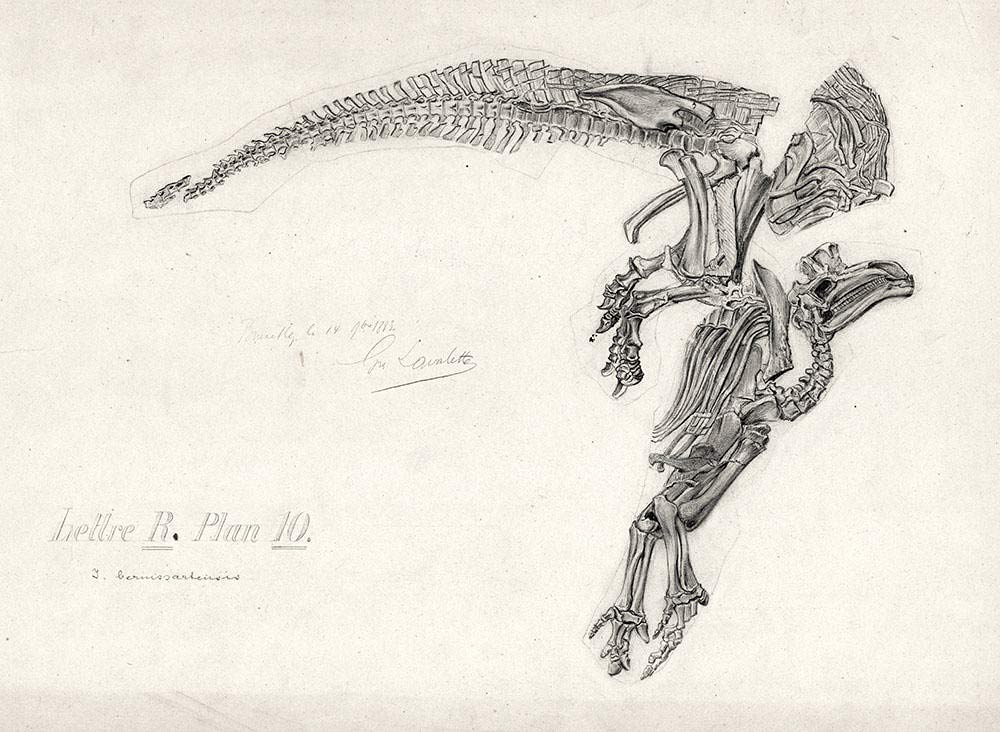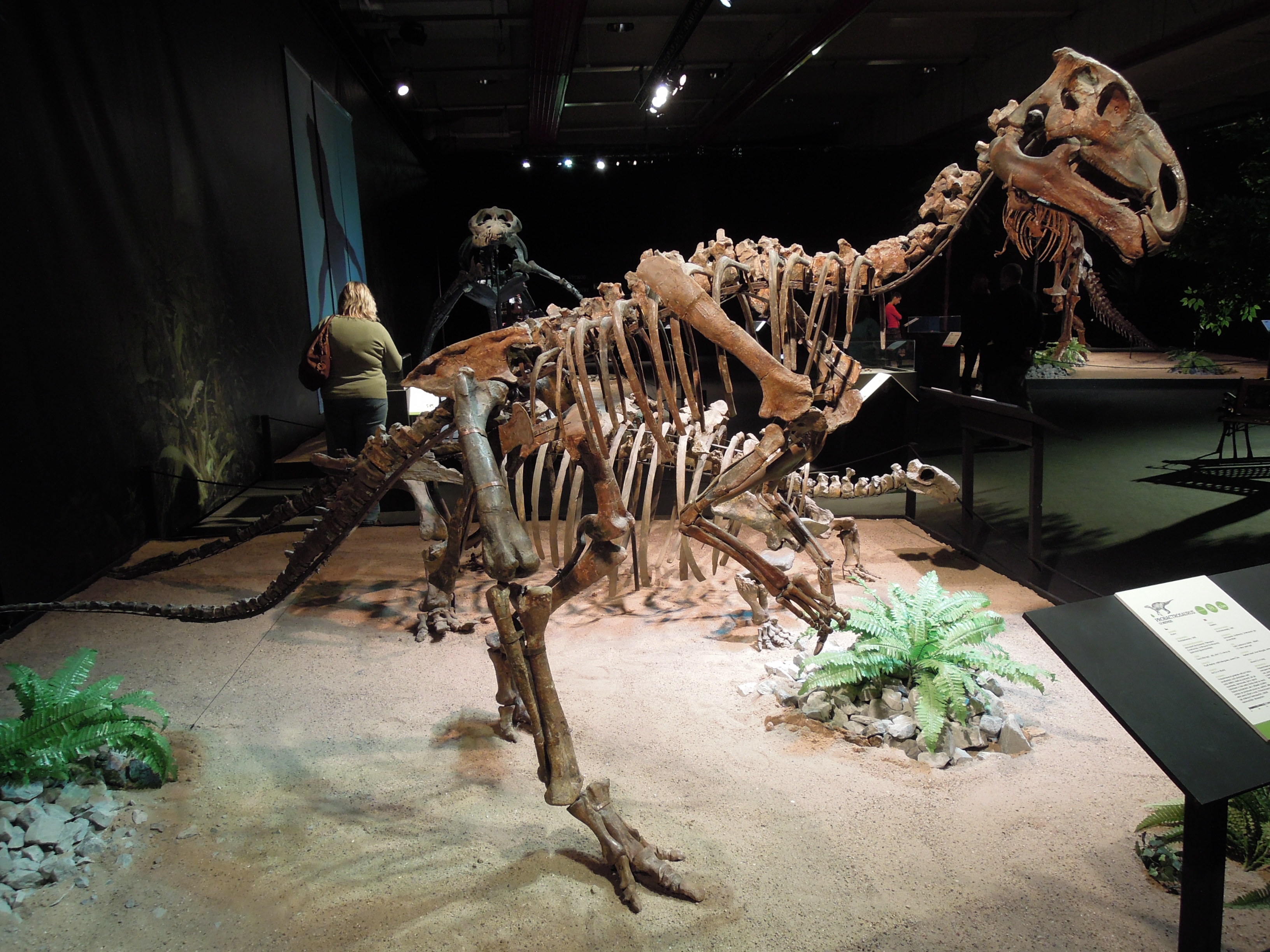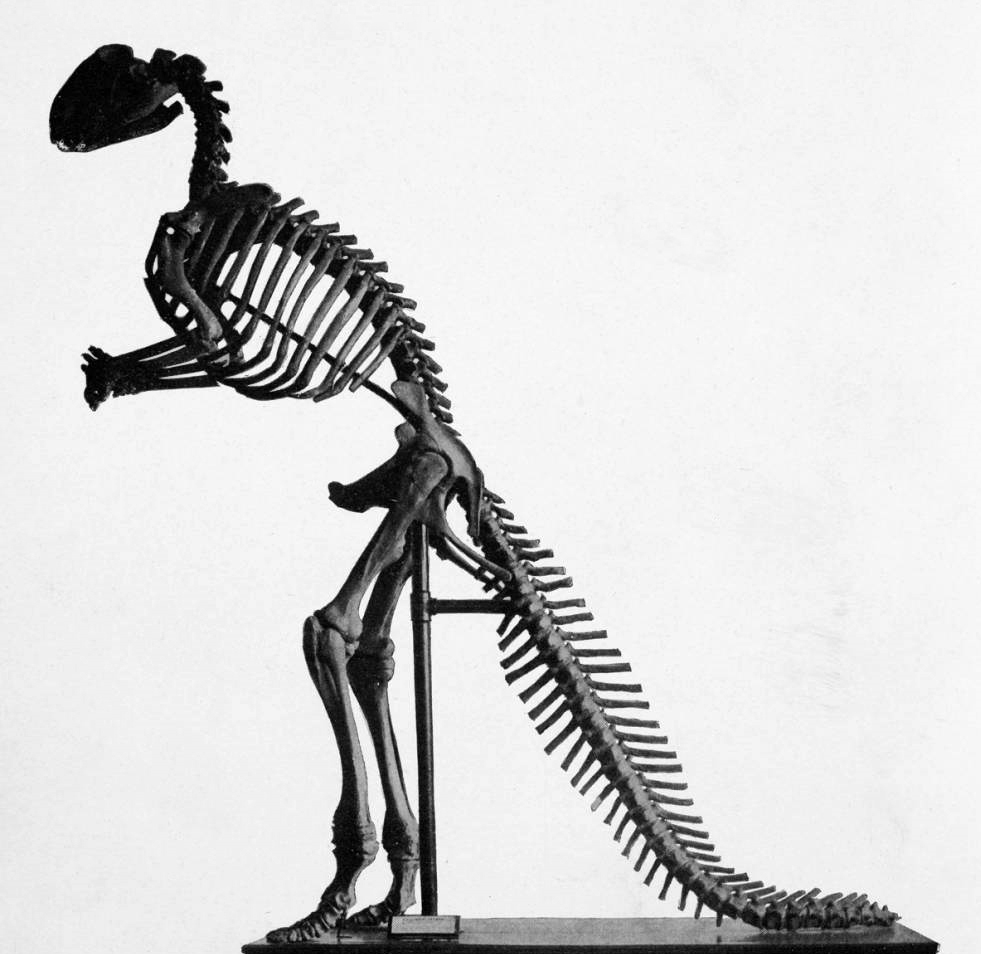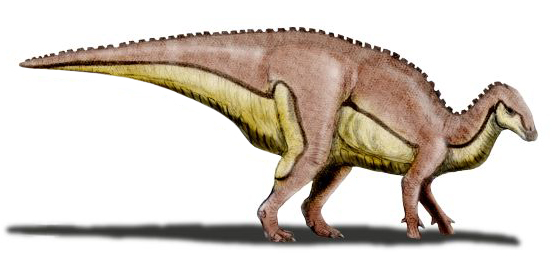|
Hadrosauroid
Hadrosauroidea is a clade or superfamily of ornithischian dinosaurs that includes the "duck-billed" dinosaurs, or hadrosaurids, and all dinosaurs more closely related to them than to ''Iguanodon''. Their remains have been recovered in Asia, Europe, Africa and the Americas. Many primitive hadrosauroids, such as the Asian '' Probactrosaurus'' and '' Altirhinus'', have traditionally been included in a paraphyletic (unnatural grouping) "Iguanodontidae". With cladistic analysis, the traditional Iguanodontidae has been largely disbanded, and probably includes only ''Iguanodon'' and perhaps its closest relatives. Classification The cladogram below follows an analysis by Andrew McDonald, 2012, and shows the position of Hadrosauroidea within Styracosterna. The cladogram below follows an analysis by Wu Wenhao and Pascal Godefroit (2012). Cladogram after Prieto-Marquez and Norell (2010). A phylogenetic analysis performed by Ramírez-Velasco ''et al.'' (2012) found a large polytom ... [...More Info...] [...Related Items...] OR: [Wikipedia] [Google] [Baidu] |
Tethyshadros Insularis
''Tethyshadros'' ("Tethys Ocean, Tethyan hadrosauroid") is a genus of hadrosauroidea, hadrosauroid dinosaur from Trieste, Italy. The type and only species is ''T. insularis''. Discovery and naming Sometime in the 1980s, Alceo Tarlao and Giorgio Rimoli reported finding fragments of dinosaur bone while prospecting for rare bones. The abandoned quarry these were found in was only 100m inland, at Villagio del Pescatore, Trieste Province, Italy. It was from this quarry that a nearly complete hadrosaur skeleton was discovered in 1994. Lying on a vertical rockface, the specimen required a difficult excavation process, involving the removal of over 300 cubic metres of mineral and use of large equipment. Palaeontologist Fabio Della Vacchia among others served as scientific director for the excavation. Many other fossils, including various other hadrosaur specimens, were uncovered in the process. The main skeleton was not extracted until 1999. The significance of the find was immediately ... [...More Info...] [...Related Items...] OR: [Wikipedia] [Google] [Baidu] |
Zuoyunlong
''Zuoyunlong'' is an extinct genus of herbivorous ornithischian dinosaur belonging to the Hadrosauroidea, that lived during the Late Cretaceous in the area of present China. Discovery and naming The holotype, SXMG V 00 004, was found by the team of the Shanxi Regional Geological Survey in a layer of the Zhumapu Formation in the province of Shanxi which dates from the Cenomanian, roughly ninety-five million years old. It consists of two bones from the right-hand half of the pelvis, a partial right ilium with the field number ZY004-001 to which the cover sheet is missing, and the lower end of the shaft of the right ischium, field number ZY004-002. Additional specimens are unassigned. In 2017 the type species ''Zuoyunlong huangi'' was named and described by Wang Runfu, You Hailu, Wang Suozhu, Shichao Xu, Yi Jian, Xie Lijuan, Jia and Lei Xing Hai. The generic name refers to the prefecture of Zuoyun with the Chinese word ''long'', "dragon". The specific name honors the Chinese paleo ... [...More Info...] [...Related Items...] OR: [Wikipedia] [Google] [Baidu] |
Koshisaurus
''Koshisaurus'' is a monospecific genus of basal hadrosauroid from the Kitadani Formation in Japan. The discovery of the genus suggests that hadrosauroids had higher diversity along the eastern margin of Asia in the Early Cretaceous. "Koshi" means an old Japanese regional name including Fukui prefecture where fossils of the genus were discovered. Description ''Koshisaurus'' was unlike most hadrosauroids due to the fact that it possessed an antorbital fossa, as well as three subsidiary ridges on its maxillary teeth, similar to those of '' Equijubus''. These ridges are also present on the also Asian genera '' Xuwulong'', ''Jinzhousaurus'' and '' Altirhinus''; but all three lack antorbital fossae, placing them as more advanced than ''Koshisaurus''., See also * Timeline of hadrosaur research A timeline is a display of a list of events in chronological order. It is typically a graphic design showing a long bar labelled with dates paralleling it, and usually contemporane ... [...More Info...] [...Related Items...] OR: [Wikipedia] [Google] [Baidu] |
Batyrosaurus
''Batyrosaurus'' is an extinct genus of herbivorous basal hadrosauroid dinosaur known from the Late Cretaceous Bostobe Formation (Santonian to Campanian stage) of central Kazakhstan. It contains a single species, ''Batyrosaurus rozhdestvenskyi''. It is possible that ''Batyrosaurus'' represents the same taxon as the doubtful '' Arstanosaurus akkurganensis'' as both were found from the same formation. The type species ''Batyrosaurus rozhdestvenskyi'' was in 2012 named and described by Pascal Godefroit, François Escuillié, Yuri Bolotsky and Pascaline Lauters. The generic name is derived from the ''Batyr'', the Kazakh hero warriors. The specific name honours Anatoly Konstantinovich Rozhdestvensky. The holotype, AEHM 4/1, was found near Akkurgan in a layer of the Bostobinskaya Formation dating from the Santonian-Campanian, about eighty-four millions year old. It consists of a partial skeleton, including a partial skull, the lower jaws, sixty individual teeth, the sterna, the ... [...More Info...] [...Related Items...] OR: [Wikipedia] [Google] [Baidu] |
Equijubus
''Equijubus'' (; ''Mǎzōng'' meaning "horse mane" after the area Mǎzōng Mountain 马鬃山 in which it was found), is a genus of herbivorous hadrosauroid dinosaur from the Early Cretaceous (Albian stage) of northwestern China. Discovery and naming The type (and only known) specimen was found in the summer of 2000 by a Chinese-American expedition in the Mazong (= "horse mane") Shan area of China's Gansu Province.You, Luo, Shubin, Witmer, Tang and Tang (2003). "The earliest-known duck-billed dinosaur from deposits of late Early Cretaceous age in northwest China and hadrosaurid evolution." ''Cretaceous Research'', 24: 347-353. In 2002 You Hialu in a dissertation named and described the species ''Equijubus normani''. The generic name is derived from Latin ''equus'', "horse", and ''juba'', "mane". The specific epithet "normani" is in honour of British palaeontologist David B. Norman. However, such a ''nomen ex dissertatione'' does not constitute a valid name. The type ... [...More Info...] [...Related Items...] OR: [Wikipedia] [Google] [Baidu] |
Portellsaurus
''Portellsaurus'' (meaning "Portell Lizard") is a genus of hadrosauroid dinosaur from the Lower Cretaceous Margas de Mirambell Formation of Spain. The genus contains a single species, ''Portellsaurus sosbaynati'', known from a partial right dentary. Discovery and naming ''Portellsaurus'' was discovered in 1998 by Miquel Guardiola, Julián Yuste and Silvia Fabregat in a site near Mas de Curolles. The generic name, ''Portellsaurus'', comes from the Portell de Morella, the town where the holotype was recovered, and the specific name, ''sosbaynati'', refers to Vicente Sos Baynat, a Spanish geologist who was the first scientist honored by Universitat Jaume I as "Doctor Honoris Causa". Description ''Portellsaurus'' is known from an almost complete right dentary, MQ98-II-1, which is stored at the Colección Museográfica de Cinctorres in Castellón. ''Portellsaurus'' can be distinguished from other styracosternans through the possession of two unique features: the absence of a bulg ... [...More Info...] [...Related Items...] OR: [Wikipedia] [Google] [Baidu] |
Penelopognathus
''Penelopognathus'' (meaning "wild duck jaw") is a genus of dinosaur which lived during the Early Cretaceous. It was an iguanodont ancestral to hadrosaurids, which also contributes to the hypothesis that hadrosauroids originated in Asia. Fossils have been found in the Bayin-Gobi Formation in what is now China. The type species, ''Penelopognathus weishampeli'', named after David Weishampel, was described by Godefroit, Li, and Shang in 2005, based on fragmentary jaw fossils. Godefroit, P., Li, H., and Shang, C.Y. (2005). "A new primitive hadrosauroid dinosaur from the Early Cretaceous of Inner Mongolia (P.R. China)". ''Comptes Rendus Palevol'' 4(8):697-705. . Its jaw is similar to that of '' Altirhinus'' and '' Probactrosaurus'', suggesting that ''Penelopognathus'' was related to the two genera. Prieto-Márquez and Carrera Farias (2021) found that ''Telmatosaurus'' was the sister taxon to ''Penelopognathus'', which was also found to be closely related to ''Lophorhothon'', as oppose ... [...More Info...] [...Related Items...] OR: [Wikipedia] [Google] [Baidu] |
Hadrosaurid
Hadrosaurids (), or duck-billed dinosaurs, are members of the ornithischian family Hadrosauridae. This group is known as the duck-billed dinosaurs for the flat duck-bill appearance of the bones in their snouts. The ornithopod family, which includes genera such as ''Edmontosaurus'' and '' Parasaurolophus'', was a common group of herbivores during the Late Cretaceous Period. Hadrosaurids are descendants of the Upper Jurassic/Lower Cretaceous iguanodontian dinosaurs and had a similar body layout. Hadrosaurs were among the most dominant herbivores during the Late Cretaceous in Asia and North America, and during the close of the Cretaceous several lineages dispersed into Europe, Africa, South America and Antarctica. Like other ornithischians, hadrosaurids had a predentary bone and a pubic bone which was positioned backwards in the pelvis. Unlike more primitive iguanodonts, the teeth of hadrosaurids are stacked into complex structures known as dental batteries, which acted as effectiv ... [...More Info...] [...Related Items...] OR: [Wikipedia] [Google] [Baidu] |
Hadrosauromorpha
Hadrosauromorpha is a clade of iguanodontian ornithopods, defined in 2014 by David B. Norman to divide Hadrosauroidea into the basal taxa with compressed manual bones and a pollex, and the derived taxa that lack them. The clade is defined as all the taxa closer to ''Edmontosaurus regalis'' than '' Probactrosaurus gobiensis''. This results in different taxon inclusion depending on the analysis. Classification Hadrosauromorpha was first used in literature by David B. Norman in 2014 in a discussion of phylogenetics of ''Hypselospinus''. In his 2014 paper Norman references another of his publications as the authority for Hadrosauromorpha, a chapter in the book ''Hadrosaurs''. However, the book was in fact published later, in 2015. Following Article 19.4 of the PhyloCode, the authorship of the clade is thus Norman (2015), while the authorship of the definition is Norman (2014). Definition Hadrosauromorpha was defined by Norman (2014 and 2015) as hadrosauroid taxa closer to ''Edmon ... [...More Info...] [...Related Items...] OR: [Wikipedia] [Google] [Baidu] |
Hadrosaurus Foulkii
''Hadrosaurus'' (; ) is a genus of hadrosaurid ornithopod dinosaurs that lived in North America during the Late Cretaceous Period in what is now the Woodbury Formation about 80 million to 78 million years ago. The holotype specimen was found in fluvial marine sedimentation, meaning that the corpse of the animal was transported by a river and washed out to sea. They were large animals ranging from and . Most of the preserved elements are very robust, unusual traits in hadrosaurs. ''Hadrosaurus'' were ponderously-built animals equipped with keratinous beaks for cropping foliage and a specialized and complex dentition for food processing. ''Hadrosaurus foulkii'', the only species in this genus, is known from a single specimen consisting of much of the skeleton and parts of the skull. The specimen was collected in 1858 from the Woodbury Formation in New Jersey, US, representing the first dinosaur species known from more than isolated teeth to be identified in North America. Usin ... [...More Info...] [...Related Items...] OR: [Wikipedia] [Google] [Baidu] |
Jinzhousaurus
''Jinzhousaurus'' is a genus of hadrosauroid dinosaur of the Early Cretaceous of China. The type species is ''Jinzhousaurus yangi''. The generic name refers to the town Jinzhou. The specific name honours Yang Zhongjian as the founder of Chinese paleontology. It was first described by Wang Xiao-lin and Xu Xing in 2001. Discovery Its fossil, holotype IVPP V12691, was found near Baicaigou in Yixian County in the Dawangzhangzi Beds of the Yixian Formation in Liaoning, China, having an oldest determinable age of 122 million years, during the early Aptian stage of the early Cretaceous Period.Zhou, Z. (2006). "Evolutionary radiation of the Jehol Biota: chronological and ecological perspectives." ''Geological Journal'', 41: 377-393. It consists of a nearly complete skeleton, compressed on a slab. Description ''Jinzhousaurus'' has a length of about 7 metres (23 ft) and its skull is about half a metre long. Its snout was elongated with large nares and lacking an antorbi ... [...More Info...] [...Related Items...] OR: [Wikipedia] [Google] [Baidu] |
Xuwulong
''Xuwulong'' is a genus of hadrosauroid dinosaur from the Early Cretaceous period. It lived during the early Cretaceous period (Aptian-Albian age) in what is now Yujingzi Basin in the Jiuquan area, Gansu Province of northwestern China. It is known from the holotype – GSGM F00001, an articulated specimen including a complete cranium, almost complete axial skeleton, and complete left pelvic girdle from Xinminpu Group. ''Xuwulong'' was named by You Hailu, Li Daqing and Liu Weichang in 2011 and the type species is ''Xuwulong yueluni''; the binomial name as a whole refers to Professor Wang Yue-lun; "Xu-wu" is his courtesy name A courtesy name (), also known as a style name, is a name bestowed upon one at adulthood in addition to one's given name. This practice is a tradition in the East Asian cultural sphere, including China, Japan, Korea, and Vietnam.Ulrich Theobald .... See also * * References Early Cretaceous dinosaurs of Asia Iguanodonts Fossil taxa described in 2 ... [...More Info...] [...Related Items...] OR: [Wikipedia] [Google] [Baidu] |







